Review of the TIDAL Piano / 6moons.com
TIDAL Piano

Tidal Audio GmbH was founded in 1999 by Jörn Janczak in Leipzig, Germany.
Jörn was 24 years old and he'd already worked as engineer and production
manager in several German high-end companies as well as having completed
a stint of machining high-tolerance parts for Mercedes Benz.
Specializing in the manufacture of high-end components for the most
demanding stereo listeners, Tidal's goal is simple: to become one
of the finest high end brands on the market, neither the biggest nor
the brand with the most aggressive advertising.
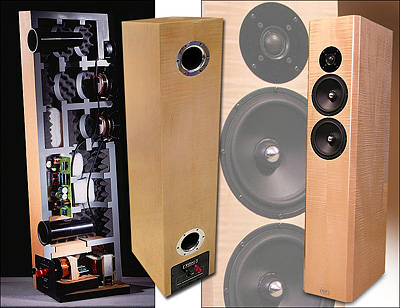
Not wanting to build 'me too' products -- not the most expensive or
heaviest -- Janczak says that he simply wanted to build the finest.
Janczak believed from the start that outstanding designs and hard
work would engender worldwide recognition.
In 2003, he was joined by Jürgen Meehsen, an investor and music lover
who is mainly responsible for financials and bookkeeping. Tidal's
name itself is inspired by one of Jörn's favorite singers, Fiona Apple
and her album Tidal. To Jörn, the word connotes eternity and continuity
"just like the tide".
Three years later, Tidal feels that it's difficult to find any brand
on the market that offers its trademark qualities of sound and finish
whether we're talking speakers or electronics. Regarding finish, it
is said that a picture is worth a thousand words. However, I could
spend another thousand words explaining why the accompanying pictures
can't possibly convey the beauty of these loudspeakers.
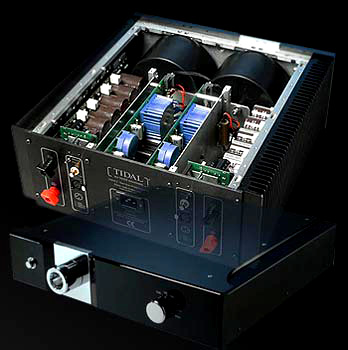
Finished in deep high gloss Tiger Maple, the Pianos are simply gorgeous
and exemplify the essence of simple elegance. So highly lacquered
and polished are they that they remind me of two polished marble monoliths,
albeit with a gorgeous maple grain and color.
Take my word for it. The pictures don't begin to hint at their beauty.
These are finished as no other speaker I've ever seen and their slender
silhouette and chamfered edges both minimize obtrusiveness (if you're
of the mind that a speaker such as this could ever intrude on décor!)
and maximize visual appeal.
I'm told that the cabinets are made and finished by a famous piano
manufacturer in Germany. The finish is actual piano polyester, not
lacquer. Polyester spraying is banned in the US for health reasons.
(It can be applied in small quantities in liquid form but that's all.)
When completed, the finish is 2 to 3 millimeters thick and virtually
impervious to the elements. The cabinet itself is manufactured to
what Tidal calls RMD specs (resonance minimizing design) and built
to be inert enough to eliminate deleterious microphonics and resonance.
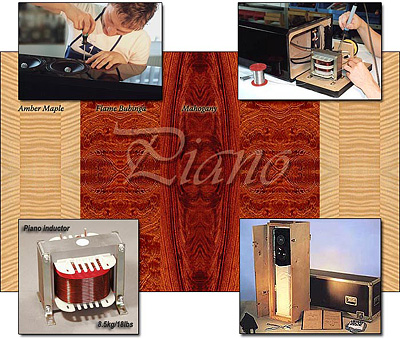
Give the speakers a knuckle rap just about anywhere - in addition
to a sore set of knuckles, you'll get a minimal and short-lived audible
verification approaching that of a cinderblock. They are rather seriously
inert. Those with small children may wish the Pianos offered some
kind of protection for their drivers but there is none (though they
can be special-ordered with grills). Seeking protection would be two
6.5-inch SEAS Excel woofers, each with a modified magnesium diaphragm,
a sophisticated motor assembly and a chromium-plated copper phase
plug.
Directly above them is the 1.1-inch modified ScanSpeak 97000 Revelator,
a highly respected fabric dome tweeter with an additional velvet coating
of the faceplate to stem diffraction.
The cabinet itself is constructed of 1.5-inch MDF and features tongue
and groove construction. Within the Piano and encapsulating the passive
crossover network is a compartment that is both mechanical and pressure
isolated. The network is said to be matched within 2% of a reference
standard.
It makes use of SUPREMECAP MKP™ capacitors, metal film resistors and
air-core inductors resulting in what is said to be an extremely linear
frequency response, excellent step response and an optimized phase
and group delay. Around back are two bass ports and a single pair
of 100-ampere gold-plated binding posts with plastic nuts fashioned
for hand-tightening only. A free option of dual pairs for biwiring
is also available on special order.
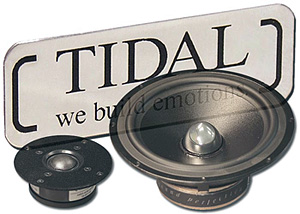
Bundled accessories include chromium-plated spikes and protective
discs, a micro-fiber cleaning cloth and an owner's manual bound in
hand-finished leather that includes actual MLSSA measurements for
each speaker. Optional finishes include a metallic acrylic lacquer
in silver grey, bordeaux, ocean blue or just about any other color
you can come up with.
For specifications, Tidal quotes nominal impedance of 4-6 ohms, a
minimum amplifier requirement of 50 watts, an efficiency of 88dB (in
room) and an F3 point of 32Hz. Each speaker measures 46 inches tall
by 9.6 inches wide by 14.3 inches deep and is canted backwards by
4° to time-align the drivers. Each speaker tips the scale at a solid
117 lbs. The speakers ship in flight cases for a combined shipping
weight of 306 lbs, including all packaging and incidentals.
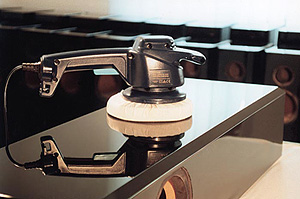
Despite the fact that the Pianos have all their drivers mounted on
the top half of the speaker, these are very bottom-heavy speakers.
One look at the cut-away picture and you'll know why. Check out the
18-pound inductor transformer (part of the lower woofer's low-pass
network) and all the bracing down there. The result is a low center
of gravity and a much more stable speaker than you'd probably suspect,
particularly once spiked.
The Piano is a two-and-a-half-way design, indicating that both mid/woofers
work in tandem to produce low bass while one woofer's response is
rolled off somewhere below the midrange, leaving vocal range duties
to a single transducer. All drivers are housed in their own damped
chambers, all wiring is point-to-point. Other than that, Tidal is
pretty tight-lipped about design parameters.
Performance wise, the Tidal Pianos have succeeded in raising the bar
of my own expectations, for what can be achieved by a modestly sized
speaker in my room. And raised it significantly. They play me something
I've never heard before. Do you believe that musical and highly resolving
are two mutually exclusive sets of priorities?
Do you think that there's no such thing as a speaker that draws out
the minutest of inner detail yet is always easy to listen to and extremely
system-friendly? Do you swear that hyper resolution must always equate
to mechanical in the end? I did.
But I've just learned that I've been wrong. It was simply a matter
of finding the right speaker. Make no mistake, the Tidal Pianos are
one such very rare speaker.
Tidal Audio Pianos ship in individual flight cases with substantial
padding to both anchor the speakers in place and protect them. Inside
the flight case the Piano is cocooned in a non-abrasive cotton sock
for further protection of the extraordinary finish. Unpacking them
was easy enough. I required no help but I'm a pretty big guy.
If you have a second pair of hands, I suggest getting them involved.
Better safe than sorry after all. At the Tidal factory, the raw drivers
are driven for 100 hours before assembly so break-in was not necessary.
After several minutes of ogling and admiring, the speakers were ready
for the listening room. Setup there was uncomplicated. The speakers
are pretty easy to dial in if you know your room.
They make no special demands. I started with them in the same vicinity
as most of my reference speakers and after some experimentation, they
ended up where they started - with their backs about 20 inches from
the front wall behind them and well away from the side walls. The
old equilateral triangle configuration worked nicely and a gentle
toe-in was used.
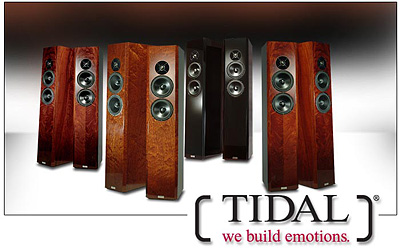
Once the music started, the Pianos proved to be a revelation, partly
because of what they don't do. What they don't do is reach out and
grab you with polytechnics or flash. In fact, it took a couple CDs
worth of listening before I felt as though I was starting to get these
speakers. At first listen what came across was buttery smooth and
completely peak and fatigue-free.
I don't believe I've ever heard a speaker that sounded so utterly
free of harshness, glare or edge. The Pianos seemed all about sweet
balanced neutrality. But quickly I began to wonder if this initially
impressive character wasn't going to devolve into something bland,
lackluster and uninvolving. I was starting to wonder if they weren't
missing a little spark, a little life. Mind you, I'm talking about
the initial minutes of listening. It's funny how one can overanalyze
during the first few moments of a session.
Nevertheless, I set out to see if I could shake things up a little
- rattle these speakers or at least get them to come out of their
shell. I popped into the player one of the dirtiest discs in my collection,
Nirvana's Nevermind [DGCD24425]. Soon I was to realize that the more
chaotic the music and the more unraveled I expected the presentation
to become, the more poised the Pianos would remain.
Rather than allowing the music to come apart at the seams, the Pianos
steadfastly remained in charge and allowed me the deepest insight
into the discs I've ever had. This was a level of sophistication I'd
never heard before; a level of accomplishment I frankly didn't know
existed. What I was soon to observe in the Pianos is their way of
reaching into the music to unearth and retrieve the minutest of musical
detail while never removing it from the context of the music as many
other hyper-detailed speakers do.
Some speakers -- JMlabs for instance -- pull out almost unbelievable
amounts of detail but in doing so, they fracture the music and it
never becomes whole again. All that fractured detail distracts and
detracts from the purpose of the music. The Pianos, however, capture
that same minutiae without dissecting the music. Rather than getting
sterile and analytical, the Pianos preserve the music's intent and
actually lend keener insight into the composer's meaning.
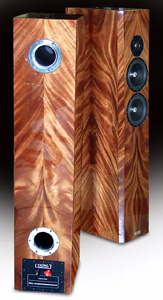
In other words, they focus your attention on the nuance of the music,
not the speakers themselves. The key to this type of resolution would
seem to be a lower noise floor and less phase shift rather than a
frequency response that artificially forces details to the surface.
In much the same way a wine aficionado tastes a wine and not only
notes the individual components that make up the wine's character
-- the peppers, the tannins, the fruity or floral elements etc. and
then proceeds to quantify and qualify them for balance and appeal
-- the listener is able to hear into the music through the Pianos
to observe the delicate interplay of instrumental timbres, contrasting
textures and differing rhythms and timing cues for a deeper appreciation
of the music.
The glass doesn't distract the wine connoisseur, the speaker doesn't
distract the listener. All attention is directed to the music. More
easily observable are the tonal variations and harmonic shadings,
not for the sake of paying kudos to the speakers but to the composer
and performers.
What's especially amazing about the Tidal Pianos and what makes them
a singular listening experience is that they can be so revealing yet
involving. So incisive yet organic. They make the strongest of cases
for being able to have your cake and eating it, too. It's the fact
that the Pianos remain so musically entrancing and affable that truly
sets them apart from other such highly resolving speakers.
There's no telltale supernatural crispness or brightness that points
to an amusical analytical speaker. As I said, at first blush the Pianos
are not what you'd expect from such an insightful pair of speakers.
They almost sound bland.
That may have been a bit of a break-in issue, maybe even a listener
acclimation issue because they've not sounded bland since - not since
I've come to understand what's really going on, anyway. They still
don't thrust their candor upon the listener.
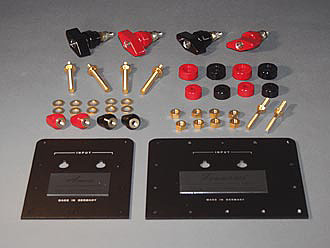
You still have to listen in to hear it. And indeed, the Pianos have
the kind of musically suggestive character that invites you to do
just that. These are the kind of speakers you can listen to all day
without fatigue. In other words, we're talking about truly extraordinary
resolution with none of the disillusion.
To use a car analogy, imagine a car that smoothes out every bump in
the road as if you're riding on a cushion of air yet corners like
it's on rails and remains in full control of the road through the
most adverse of conditions. I've been listening to this Nirvana disc
for what seems like forever. I've used it on more systems than I could
possibly recollect. But through the Pianos, I heard into it as I've
never heard before. For one thing, Chris Novoselic's bass sounded
completely fresh.
I heard it pulsating with a more highly differentiated sense of micro
dynamics and tonal depth that was completely new as was its sense
of tempo. I gained access into Kurt Cobain's voice revealing a new
significance, body and harmonic layering that I had no idea had been
captured on the disc.
Despite the surrounding auditory chaos, I could hear Cobain's vocals
as clearly as if he was singing a cappella. I could go on and on with
the list of revelations. It was truly a sense of finally hearing the
forest for the trees, of observing the calm despite the storm. There's
very little overt about the Pianos.
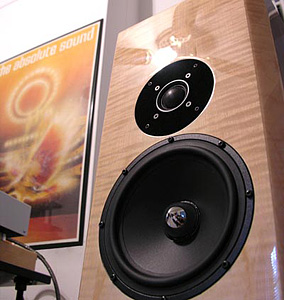
What they do -- and what they do is considerable -- they go about
doing in a fairly understated way. Nothing with the exception of their
smooth overall character jumps out at you. They are superbly balanced.
Dynamically speaking, these speakers will on occasion surprise you.
The most micro of micro dynamics are less pronounced than on some
other speakers such as horns and single-driver speakers.
But by comparison, the Pianos can make such speakers sound almost
unnaturally jittery and nervous. In my experience, such micro dynamics
are only apparent from live music when you're very close to the musicians.
Like razor sharp imaging, such dynamics are rarely found when seated
in the audience. Many find them to heighten the sense of reality and
intimacy of reproduced music and those that do will get no argument
from me.
On occasion, however, the Pianos will startle you with microbursts
of energy. The soundtrack from Casper [MCA 11240] is filled with such
orchestral eruptions, intended to shock and awe the audience as would
the sudden appearance of a ghostly apparition.
The Pianos communicated these orchestrated eruptions with striking
ease. When these events were coupled with hefty bass (and there's
a lot of that on this disc), so much the better. The Pianos are exceptionally
coherent and quick in the bass and the speakers turn on a dime.
The Pianos present music with an outstanding sense of pace and rhythm.
Timing changes in Jazz and Big Band are more expressive and when a
musician, as Max Roach would say, colors around the beat, there's
no missing it over the Pianos.
Attacks and decays are well preserved and naturally presented. Depeche
Mode is known for innovative techno, relatively complex arrangements,
prodigious amounts of bass and copious amounts of incisive percussion.
Music For The Masses [Sire9 25614-2] was a complete success over the
Tidal speakers.
Though a fairly bright-sounding disc, the Pianos managed to keep it
in the comfort zone even at high levels. Most tracks produced a soundstage
that was large and spacious, frequently (though not always) wall to
wall. Dynamic contrasts were nicely articulated as intended rhythms
were successfully communicated.
From time to time, a few more cycles of bass extension would have
behooved the synthetic presentation. But as far as they went, the
Pianos produced a lively and substantial rendition that made up for
the missing subterranean reach with snappy room-filling energy that
never strained even at enthusiastic levels. In other words, the Pianos
may not produce the deepest bass fundamentals but what is there is
very quick, very detailed and very full.
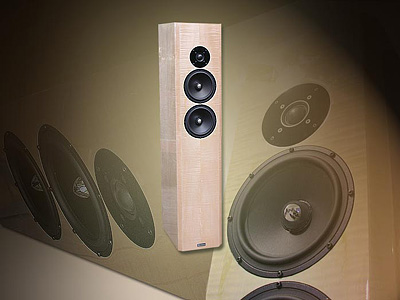
In my room, the Pianos were very full down to 30Hz, with usable output
at 25Hz. Down to their limit, the Pianos are so good that they are
one of the few speakers I doubt can be easily improved upon with a
subwoofer. I'm sure it can be done but it won't be accomplished without
some expertise in subwoofer splicing. You'll want to mate the speakers
with an exceptionally fast sub.
Think REL or comparable subwoofers, perhaps even Tidal's own subwoofer,
the Drum (though I haven't heard that one). Lest I convey an impression
of an overly sophisticated bass that is all glory and no guts, cue
up "Who Made Who" from AC/DC Live [Epic E2K 80215] and crank it up!
The Pianos really produce a wallop! Witness a bass drum that energizes
the room and gut alike.
While you're at it, notice how the CD/speaker combo combines to fill
the room with palpable energy for a remarkable sensation of actually
being there in the audience. With sophisticated fare, these speakers
are remarkably refined.
But when the music calls for it, these speakers can get loud and raunchy.
They can rock. The Pianos provided insight anew to Neal Young's Harvest
Moon LP [Reprise 9 45057-2] and restored long lost excitement, so
much so that I listened to the disc over and over. While never sounding
supernaturally edgy or overly crisp, the Pianos stacked the listening
experience with details upon details.
Young's harmonica came across with unusual clarity as the Tidals extracted
each and every component of every riff. It was the same with Young's
guitars.
His slightly offbeat rhythms were highly palatable and easily digestible,
his occasional misfingerings slightly more obvious which added humanity
to his playing. Each single note came across with exceptional nuance
and meaning. Easily witnessed were the hammering of the strings and
occasional fret buzz.
Not the one with the surest of voices, I often heard Young's vocals
waver back and forth. The bass in the recording is slightly overblown
but richly textured and was deftly handled by the Tidals. The first
several footfalls on the recording had me looking outside my room
to see who had just entered the house slamming the door behind. From
the rumbling bass to the harmonica's overtones, the Pianos allowed
me to see into the recording as never before.
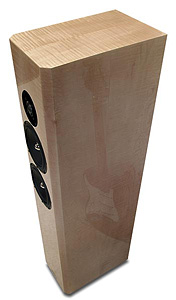
I enjoyed superb clarity and dimensionality which made for a much
more interesting listening experience than what I usually experience.
Even more important, it was 100% enjoyment and zero fatigue. Late
in the review period I did something I never would have attempted
on my own. At the behest of Tidal's affable US distributor, Half Note
Audio's Daniel Barnum, I replaced the 500-watt Bel Canto e.One Reference
1000 monos with the 16-watt Art Audio Carissa, a tube amplifier utilizing
the 845 output tube.
I was cautious at the outset but eventually stunned to hear just how
well the Carissa pushed the Pianos. They may be rated at only 88dB
efficiency but these speakers are cream puffs to drive. On Green Day's
American Idiot [Reprise 48777-2], average levels of 90dBs with peaks
of 96dBs were achieved with no sense of strain at the speakers, just
my ears. SPLs notwithstanding, the disc sounded fabulous as the Piano/Carissa
combo delivered powerfully solid bass drums on "St. Jimmy" and "Homecoming",
crystalline acoustic guitar strings on "Wake Me Up When September
Comes", superb clarity on Billy Joe Armstrong's vocals on "Whatshername"
and all the expected raucous energy of the CD's title cut.
Once the Art Audio amplifier made it into the system, it never came
out. A nearly perfect speaker then? Well, not quite. I still haven't
found those. I was very mildly disappointed with solo vocals that
I knew to be extremely well recorded, such as the simple Hawaiian
vocal arrangement of Keali'l Reichel [E O Mai, Punahele 17862 ].
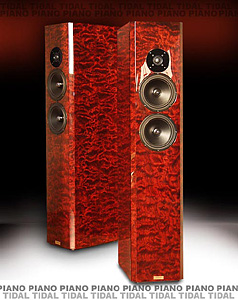
I've heard his voice reproduced with stunning clarity and intimacy
by the Third Rethm's DX55 Lowther and in this one area, the Tidals
couldn't quite compete. The Pianos couldn't lay bare the vocal textures
with the same degree of detail and clarity as the Rethms. Of course,
this is the Rethm's raison d'être and precious few speakers can compete
on its turf. It's just that the Tidals set the bar so high in all
other areas that I had hoped for just a little better.
In truth, they didn't miss the mark by much. And of course, in no
other area of performance could the Rethms even hope to compete. Bass
response? Forget it. Treble extension? Get real. Overall smoothness,
build quality and fit'n'finish? Not even close. The Pianos are not
quite the last word in low volume declaration.
Not a regular practitioner of abusive outputs, I average sound pressure
levels of around 80dB. 85 is fun and mid 90s are just about as out
of control as I get in normal listening. But I noticed two things
about the Pianos. First, they do appreciate being goosed just a little
bit, just a few clicks past my norm, nothing outrageous or dangerous.
They just seem to bloom at this slightly higher output to come alive.
More so than most speakers in my experience, the Tidals will strongly
suggest to you the proper playback of your recordings. Secondly, that
aforementioned smooth and congenial character means that even at boisterous
levels, the Pianos are exceptionally pleasant to listen to over extended
listening sessions and that fatigue factor is vanishingly low.
As I've already mentioned, the Tidals can't dredge up an uncut 20Hz
fundamental nor manage the very lowest bass as contained on organ
recordings. Those subsisting on a steady diet of cannon blasts may
want to look elsewhere. I won't gloss over this deficiency. It would
be really nice in a speaker that costs $17,000/pr. However, on most
recordings and with most styles of music, the Pianos produce a satisfyingly
robust, full-bodied and extremely articulate bass response that won't
overwhelm medium-sized rooms like mine.
Most speakers with a healthier bass output will be significantly larger
than the Pianos and physically dominate the room to a far greater
extent. Though a warmer speaker overall, in terms of bass output the
Pianos are akin to what I get from my Thiel CS2.4s yet when the recording
is up to it, the Pianos will reach down and pull up a dose of detail
the Thiels can't. In fact, the Pianos produce the most natural sounding
bass I've ever heard in my room.
Subwoofers may go deeper but the Tidals' bass seems perfectly integrated.
The Pianos' insightful yet musically congenial nature is partly the
result of a tweeter that knows its place and doesn't need to show
off and make its presence known.
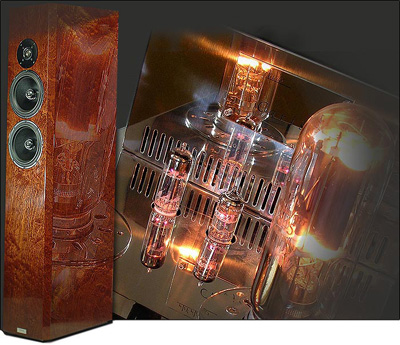
Consequently, these speakers sacrifice some of the air of speakers
with a more pronounced forward treble balance. They don't sound quite
as open and they won't exaggerate the sense of space. I found that
a very short period of acclimation was required to make that adjustment.
Then I was rewarded by treble refinement that made the Thiel CS 2.4
sound raucous and mechanical by comparison to the Piano's smooth,
sweet and highly refined nature. That's no slam on the Thiel, mind
you. It's an excellent speaker.
The Tidal just occupies the next level up. So think not of these observations
as criticisms or caveats but just more observations. I don't downgrade
the Pianos in the least for these deviations from my own personal
vision of perfection.
The Piano is what it is and is a great speaker. In terms of system
transparency and the ability to hear what's upstream, they were somewhat
of a paradox. You'd think that such a neutral speaker with the heightened
ability to resolve inner detail would highlight or exacerbate upstream
deficiencies.
Not that I suffer from these but as I swapped in and out components
and experimented with peripherals, I found that the basic tenets of
the Piano's signature remained relatively unchanged. That's not to
say you'll want to mate them with your classic Technics receiver but
as Wilson Audio is known to demonstrate, the Pianos don't suffer much
if they represent the majority of your system-buying budget.
You need not fear mating them with products of a slightly more - pedestrian
lineage. However, there's no doubt that the Pianos will make the most
of what you feed them. They had me appreciating my fairly costly digital
front end as I never have before. In fact, I feel that I'm now hearing
my Accustic Arts transport and Audio Aero converter in a completely
new light.
Never before had digital sounded so right, so rhythmic and so alive.
What blew my mind was when a guest listener looked up in the middle
of a CD and remarked, "That's a really good CD transport". I guess
I shouldn't be surprised that a great pair of speakers would reflect
well on other well-designed components in the chain.
My guest listener also said something else of interest. This economically
prudent fellow has been coming over to hear review speakers for years
and seems to make sport out of finding reasons to not be enthralled
by them.
Well, I was floored at the end of this session when he told me that
if he had the money, he'd buy them. That was a first. If I had to
list my favorite aspects of the Tidal Piano's performance in order
of preference, I'd have a difficult time deciding between its smooth
well-balanced and fatigue-free character -- to which you really can
listen to all day -- and its way with rhythm, timing and pace as it
imbues music with a degree of life and conviction that few other speakers
do.
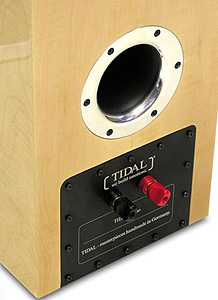
The Pianos make old recordings new and fun again and they really do
have me discovering my music collection. The Piano's combination of
midrange articulation and fine flowing dynamic expression is captivating.
So smooth, so revealing; so sophisticated and expressive of nuance
- so utterly satisfying.
A sizeable portion of the Piano's price is the result of the costly
finishing process. Did I mention sixteen polished coats of clear piano
varnish outside and a coating inside of melamine resin to seal the
speaker from damaging humidity? There will be those who think that
paying for eye candy is silly and a waste. No doubt, many of these
naysayers will be among those who can't afford the Pianos.
To those who can, I would say that at least as much time is spent
looking at one's speakers as listening and there's a lot to be said
for making them as aesthetically pleasing as possible. These speakers
are beautiful. The Tidal Pianos combine a luxuriously deep and highly
polished finish with fine woods and a simple yet elegant shape as
no other speakers I've ever encountered do.
The Tidal Pianos' beauty goes much deeper than veneer or gloss, however.
What they produce is every bit as lovely as their appearance. If you
can afford them -- or even if you can't -- see if you can arrange
an audition. I haven't heard every great speaker in the world but
I'm convinced that the Piano deserves its place among the very best.
There's something very different about these Pianos, something very
special. I've never yet had to have speakers of the Piano's cleary
superior -- and concomitantly costly -- caliber.
Yet they operate so clearly on a higher plateau than what I presently
own; and work as a true full-range speaker in my smallish room without
causing any of the usual problems; that I'm committed to liquidate
a few investments and get my own piano into the house.
The fact that I can't play isn't lost on me. What otherwise would
be a trophy purchase -- suggesting to visitors that I can tickle the
ivories -- becomes an essential acquisition that plays itself.
And unlike those programmed instruments, these pianos make music more
organically than I knew to expect from electronic playback.
Believe me, that I didn't expect. I thought I'd pretty much heard
it all by now. Apparently not...

